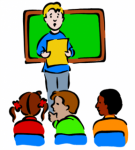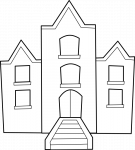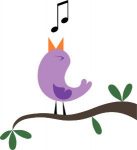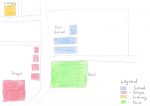 This week students are starting to round off their main body of assessable work for the term. Older students are completing and starting to present their presentations, while younger students have posters and models to finish off.
This week students are starting to round off their main body of assessable work for the term. Older students are completing and starting to present their presentations, while younger students have posters and models to finish off.
Foundation/Prep/Kindy to Year 3
Students in our stand-alone Foundation/Prep/Kindy unit (F.2) are continuing to explore with their senses this week. While still working on their model or collage for their Favourite Place, they are using their sense of Smell to consider which aromas they like or dislike. Teachers (and students) can bring in a range of things with different smells to explore in class. Ideas for these are given in the Teacher’s Handbook. An important part of this investigation is considering how one can represent one’s favourite smells in the model or collage – students might try to draw the objects associated with the smells, or see if they can find creative alternatives to represent this sense.
 Students in integrated Foundation/Prep/Kindy and Year 1 classes (Unit F.6) and those in Years 1 (Unit 1.2), 2 (Unit 2.2) and 3 (Unit 3.2) are completing their posters to be displayed next week. These posters cover topics of local significance – either local history information, or dealing with issues, such as littering or the need for play equipment. As the students work on the posters, teachers are holding discussions with them on responsibility for different issues. The delegation of responsibility to members of the community, local government, other authorities, people who use the facilities, the school P&C, the students etc. should be discussed in class, so that students start to understand how people have different responsibilities in different situations. The teacher can also revisit issues of responsibility in the classroom – what are the students responsible for? What is the teacher responsible for? What is the school responsible for? These discussions are an important means of allowing the students to interact and practise group discussion skills, as well as helping them to think about responsibilities.
Students in integrated Foundation/Prep/Kindy and Year 1 classes (Unit F.6) and those in Years 1 (Unit 1.2), 2 (Unit 2.2) and 3 (Unit 3.2) are completing their posters to be displayed next week. These posters cover topics of local significance – either local history information, or dealing with issues, such as littering or the need for play equipment. As the students work on the posters, teachers are holding discussions with them on responsibility for different issues. The delegation of responsibility to members of the community, local government, other authorities, people who use the facilities, the school P&C, the students etc. should be discussed in class, so that students start to understand how people have different responsibilities in different situations. The teacher can also revisit issues of responsibility in the classroom – what are the students responsible for? What is the teacher responsible for? What is the school responsible for? These discussions are an important means of allowing the students to interact and practise group discussion skills, as well as helping them to think about responsibilities.
Years 3 to 6
 Students in Year 3 (Unit 3.6) are completing their presentation on an extreme climate explorer and may start presenting it to the class this week. Year 4 students (Unit 4.2) are presenting on their explorer of Africa and South America. Year 5 students (Unit 5.2) are presenting on their chosen explorer from North America; and Year 6 students (Unit 6.2) are presenting on their chosen explorer from Asia. The remaining 3 weeks of this unit are allocated to the presentations, to ensure enough time for these to be given in full. The presentations should cover all the aspects raised over previous weeks and answered in the Student Workbook – the environments and geography of the areas explored; sustainability issues, such as extinction of animals and changes in local environments; characteristics of the countries involved in the explorations; reasons for explorations and how these created the background which led to the settlement of Australia and the role of indigenous people, as well as impact on indigenous people and their environments. The presentation is thus a comprehensive body of work.
Students in Year 3 (Unit 3.6) are completing their presentation on an extreme climate explorer and may start presenting it to the class this week. Year 4 students (Unit 4.2) are presenting on their explorer of Africa and South America. Year 5 students (Unit 5.2) are presenting on their chosen explorer from North America; and Year 6 students (Unit 6.2) are presenting on their chosen explorer from Asia. The remaining 3 weeks of this unit are allocated to the presentations, to ensure enough time for these to be given in full. The presentations should cover all the aspects raised over previous weeks and answered in the Student Workbook – the environments and geography of the areas explored; sustainability issues, such as extinction of animals and changes in local environments; characteristics of the countries involved in the explorations; reasons for explorations and how these created the background which led to the settlement of Australia and the role of indigenous people, as well as impact on indigenous people and their environments. The presentation is thus a comprehensive body of work.

 Foundation/Prep/Kindy to Year 3
Foundation/Prep/Kindy to Year 3 Students in Years 3 to 6 are continuing with their project on an explorer. Students in Year 3 (
Students in Years 3 to 6 are continuing with their project on an explorer. Students in Year 3 ( NAPLAN’s over and it’s time to sink our teeth into the main body of curriculum work before mid-year reporting rolls around. Our younger students are using all their senses to study the environment and local area around them, whilst our older students are hard at work on their Explorer projects.
NAPLAN’s over and it’s time to sink our teeth into the main body of curriculum work before mid-year reporting rolls around. Our younger students are using all their senses to study the environment and local area around them, whilst our older students are hard at work on their Explorer projects. Students in Years 3 (
Students in Years 3 ( Well, NAPLAN is behind us for another year and so we can all concentrate on curriculum work again! This year we have updated our assessment material to make it even easier to map the answers in the Student Workbooks with the curriculum codes. Remember, our units integrate across several curriculum areas. The model answers now contain colour coded curriculum codes that look like this:
Well, NAPLAN is behind us for another year and so we can all concentrate on curriculum work again! This year we have updated our assessment material to make it even easier to map the answers in the Student Workbooks with the curriculum codes. Remember, our units integrate across several curriculum areas. The model answers now contain colour coded curriculum codes that look like this:  Please make sure that you have the latest updates of both the model answers and the assessment guides for each unit that you are teaching, with the codes as shown here. If you don’t have the latest updates, please download them from our site. Log in with your
Please make sure that you have the latest updates of both the model answers and the assessment guides for each unit that you are teaching, with the codes as shown here. If you don’t have the latest updates, please download them from our site. Log in with your  It’s NAPLAN week and that means time is short! Fortunately, the Understanding Our World™ program is based on 9 week units, which means that if you run out of time in any particular week, it’s not a disaster. Furthermore, we have made sure that there is plenty of catch-up time within the lessons, so that there is no need to feel rushed. This week students are getting into the nitty gritty of their term projects. Our youngest students are studying their surroundings at school and in the local area. Older students are getting to the core of their research projects.
It’s NAPLAN week and that means time is short! Fortunately, the Understanding Our World™ program is based on 9 week units, which means that if you run out of time in any particular week, it’s not a disaster. Furthermore, we have made sure that there is plenty of catch-up time within the lessons, so that there is no need to feel rushed. This week students are getting into the nitty gritty of their term projects. Our youngest students are studying their surroundings at school and in the local area. Older students are getting to the core of their research projects. Students in our standalone Foundation/Kindy/Prep class (
Students in our standalone Foundation/Kindy/Prep class ( Students in Year 3 (
Students in Year 3 ( This week all of our students start to get into the focus areas of their units. For our youngest students that means starting to examine their “
This week all of our students start to get into the focus areas of their units. For our youngest students that means starting to examine their “ Students doing our stand-alone Foundation/Kindy/Prep unit (
Students doing our stand-alone Foundation/Kindy/Prep unit ( Students in Years 3 to 6 start their research projects this week. Students doing unit
Students in Years 3 to 6 start their research projects this week. Students doing unit
Aunt Madge's Suitcase was a really fun activity! The children were really interested in all the places she travelled to,…
Indi Alford, Teacher